This document discusses representations of disability in British television media, specifically the factual program The Undateables. It aims to determine whether such representations are positive or negative. Through a content analysis of The Undateables, the researcher explores the hypothesis that negative attitudes toward disability are socially constructed by media portrayals rather than natural. Key findings included portrayals of people with disabilities as "other," pitiable, undesirable, amusing, and a burden communicated through disabling language, camera angles, and music.
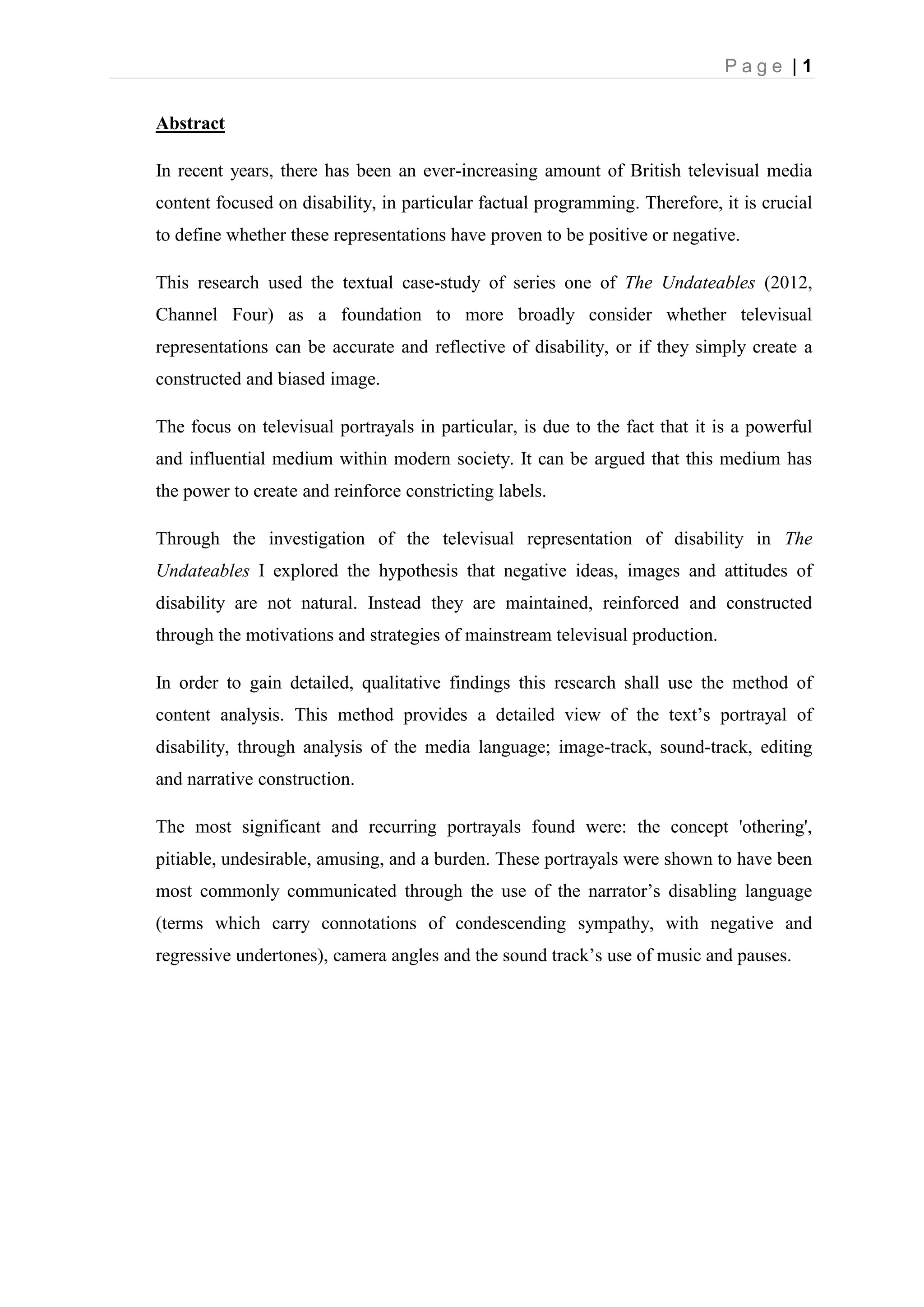
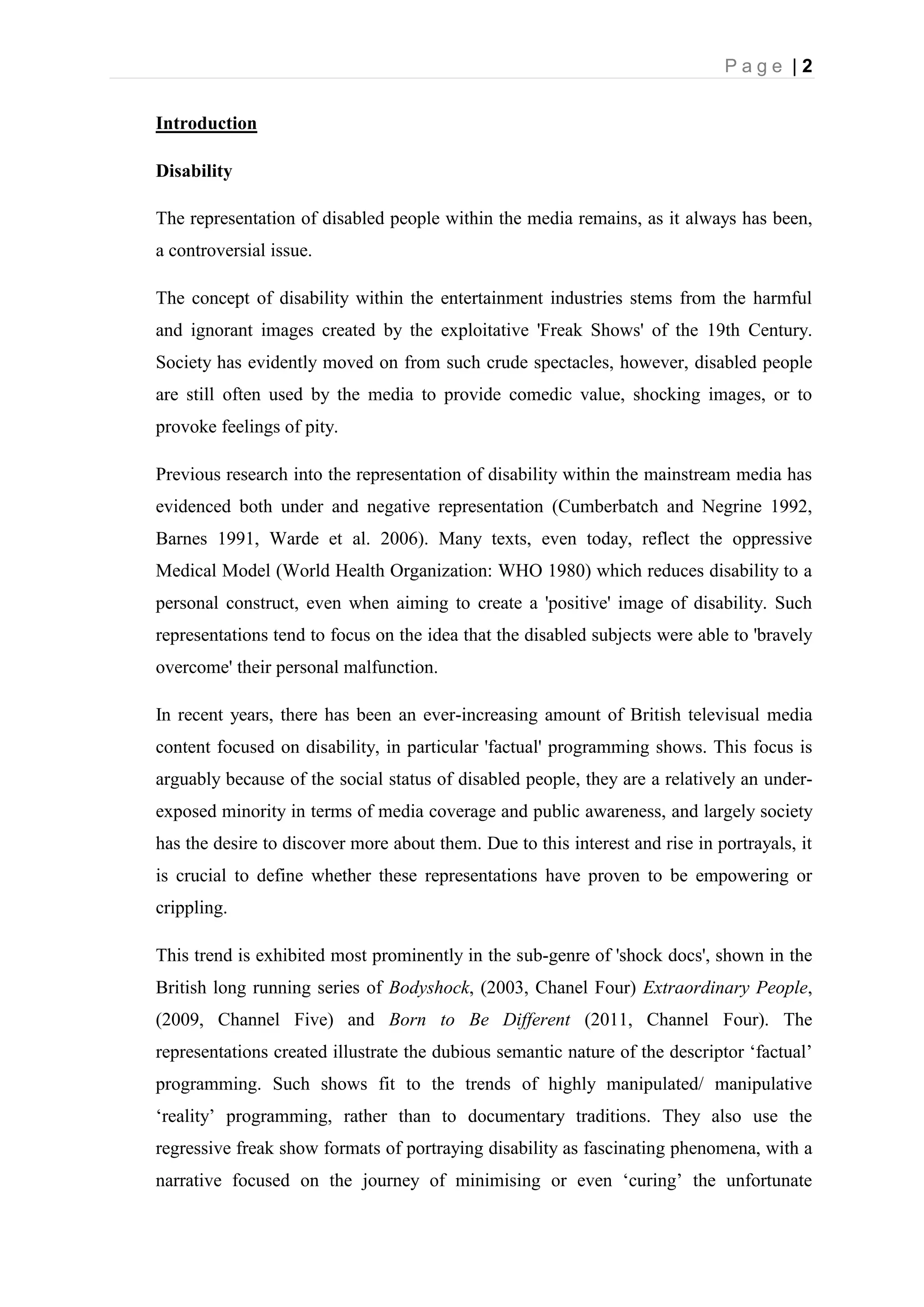
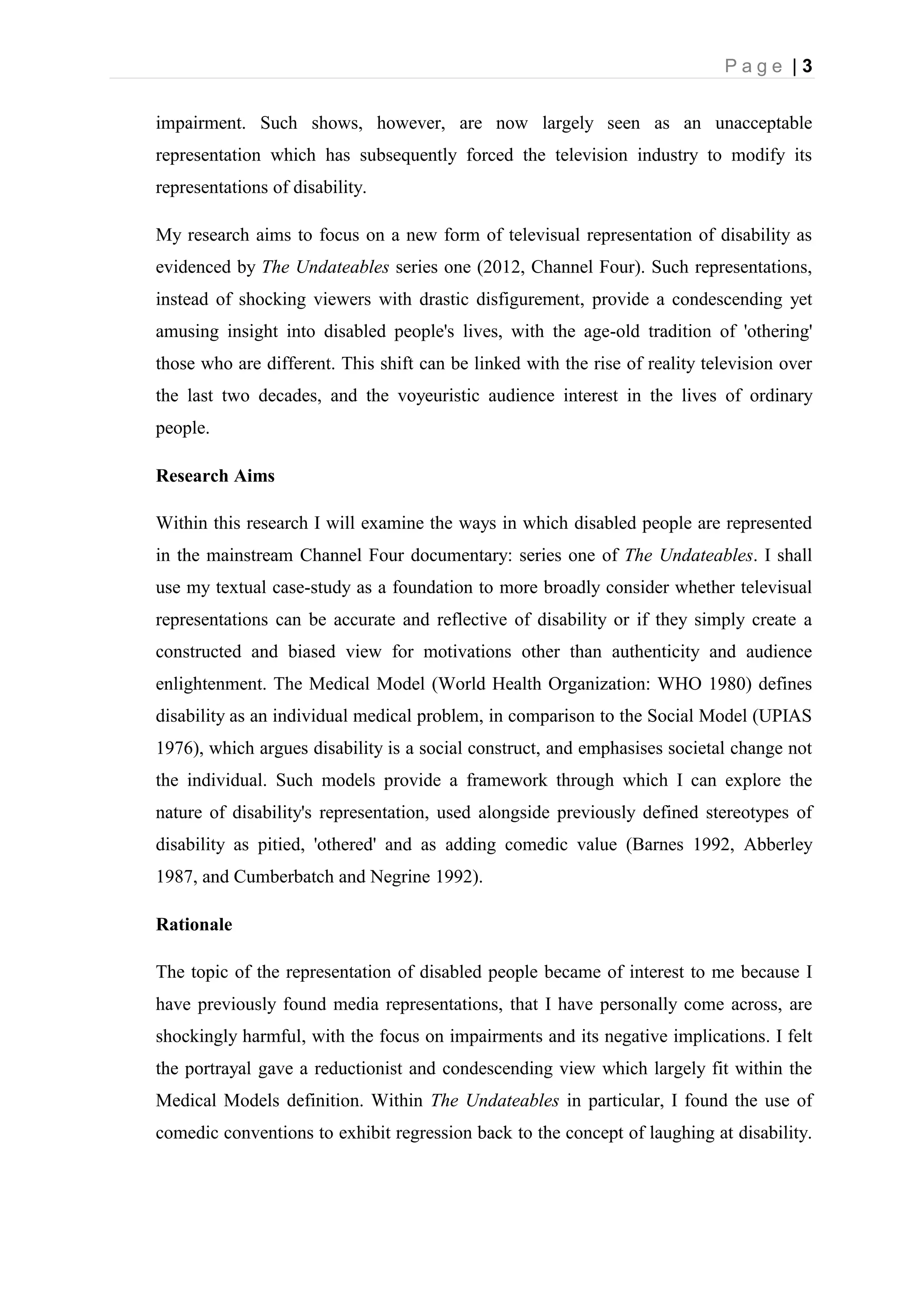
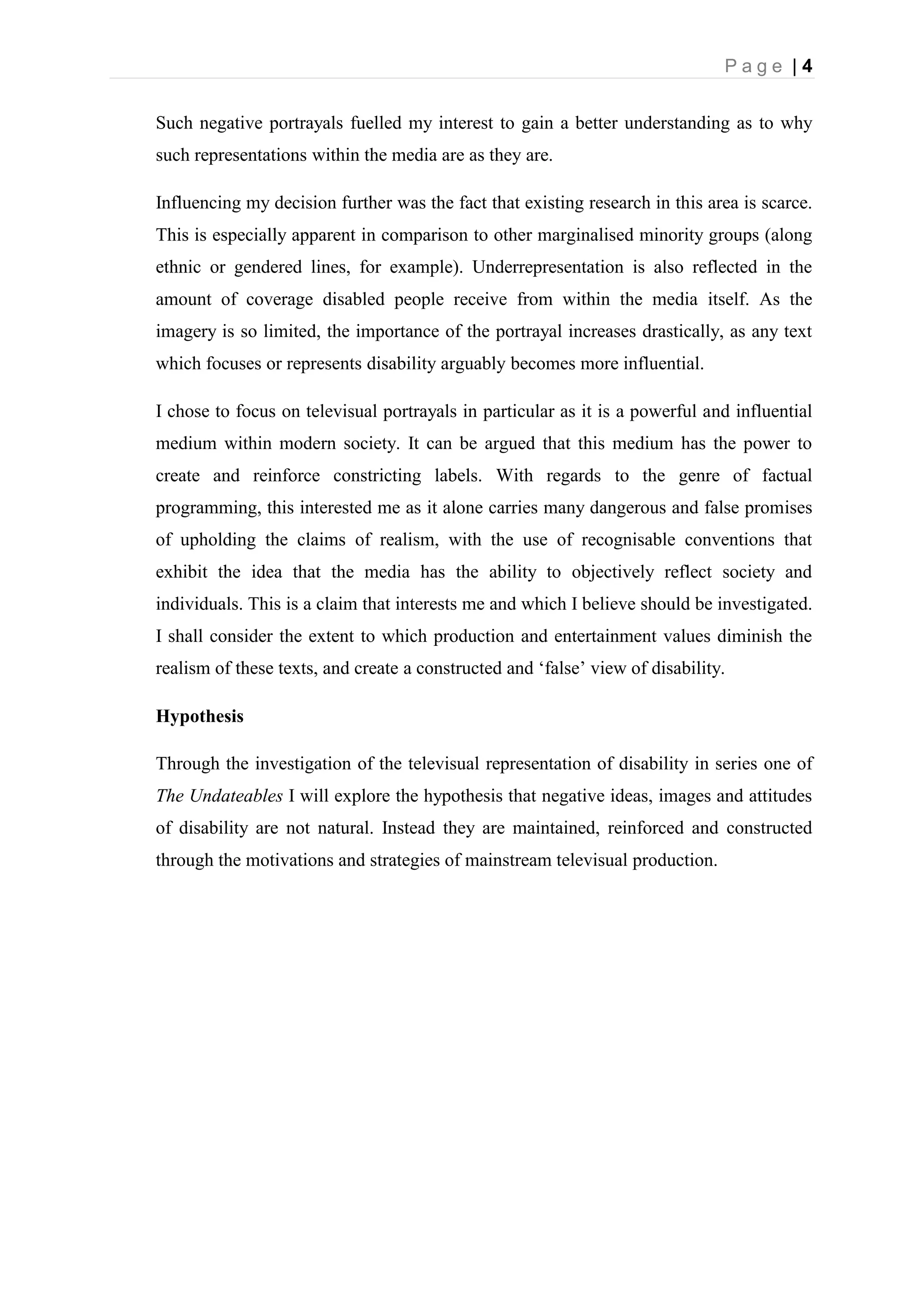

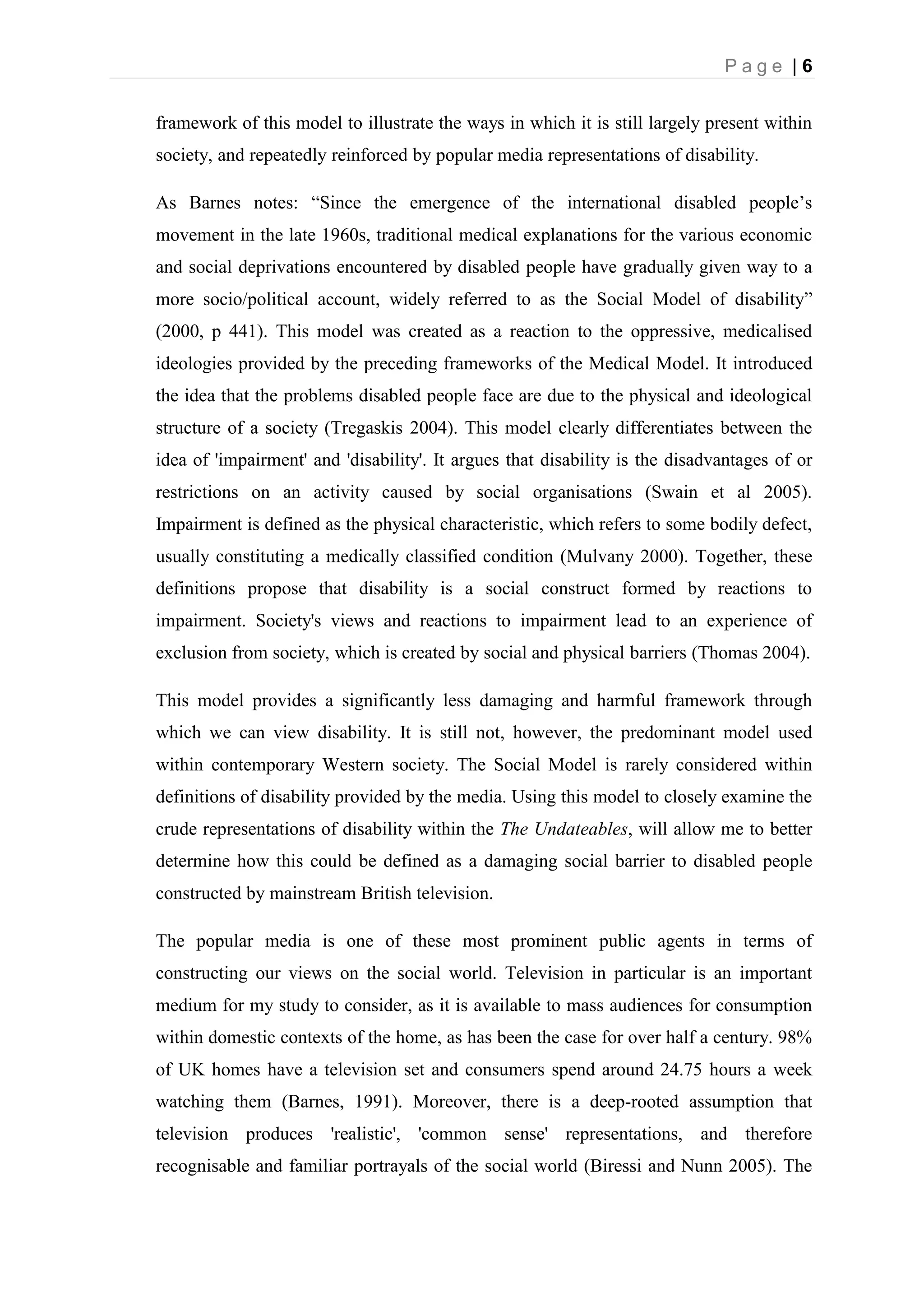
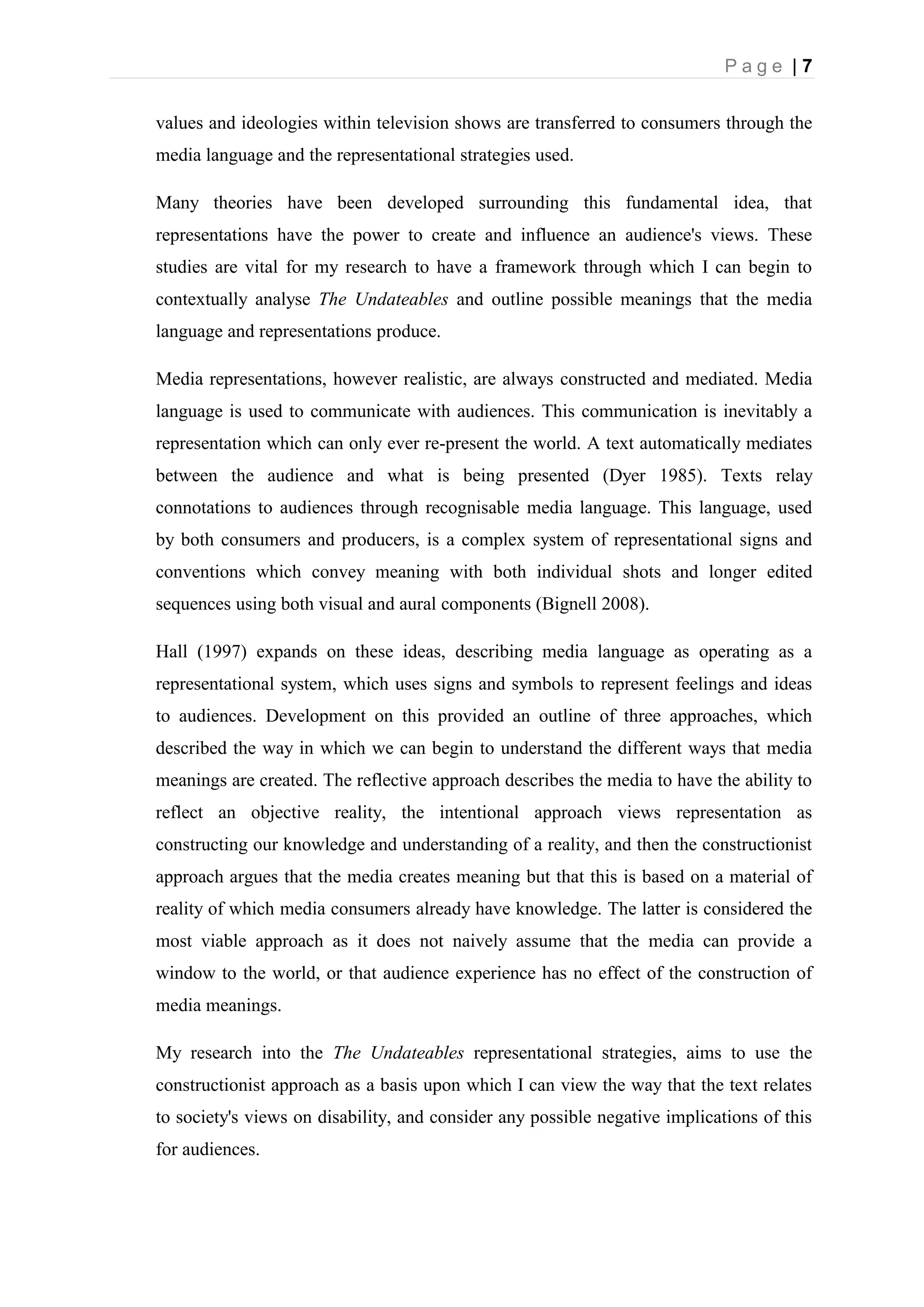


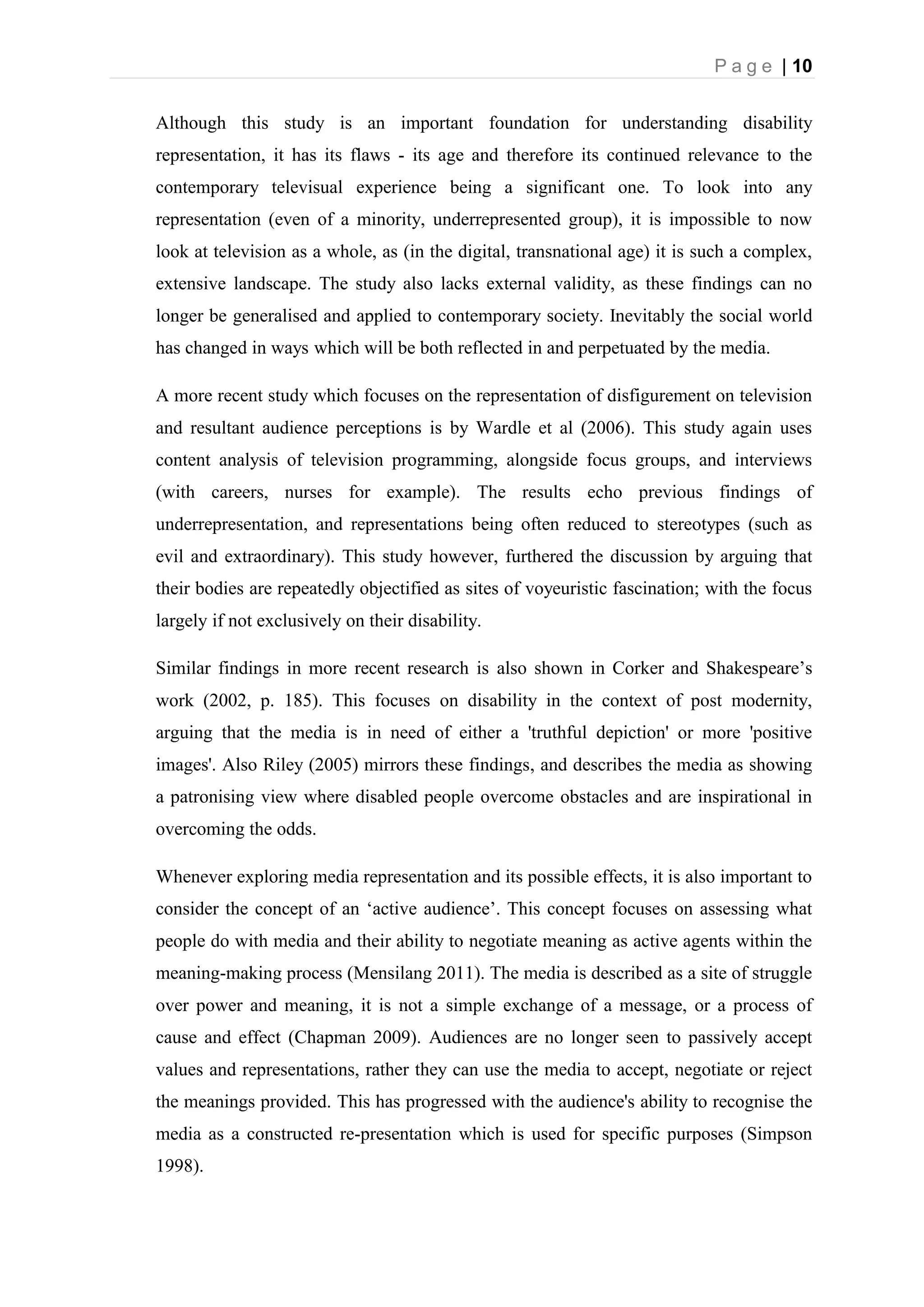
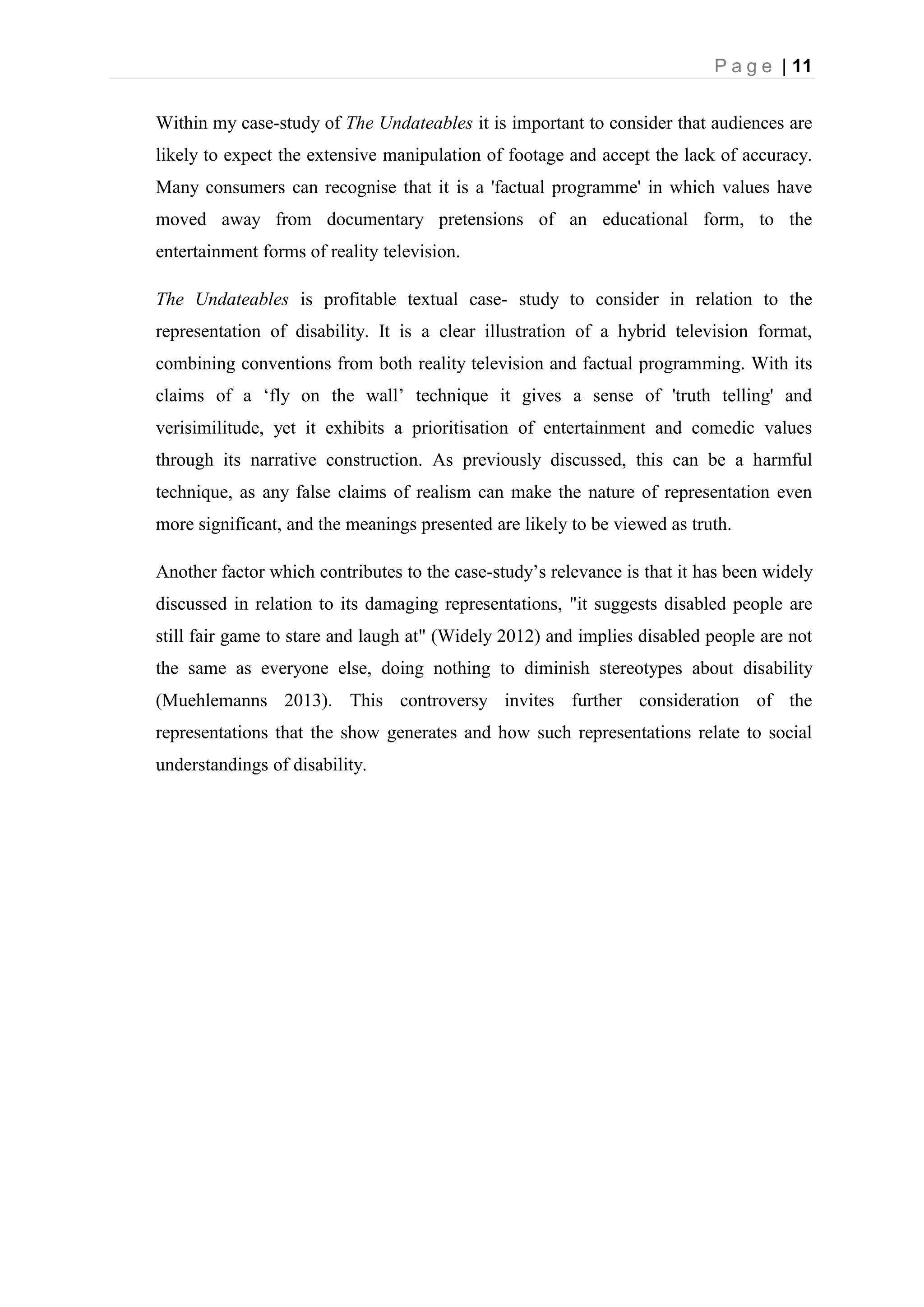
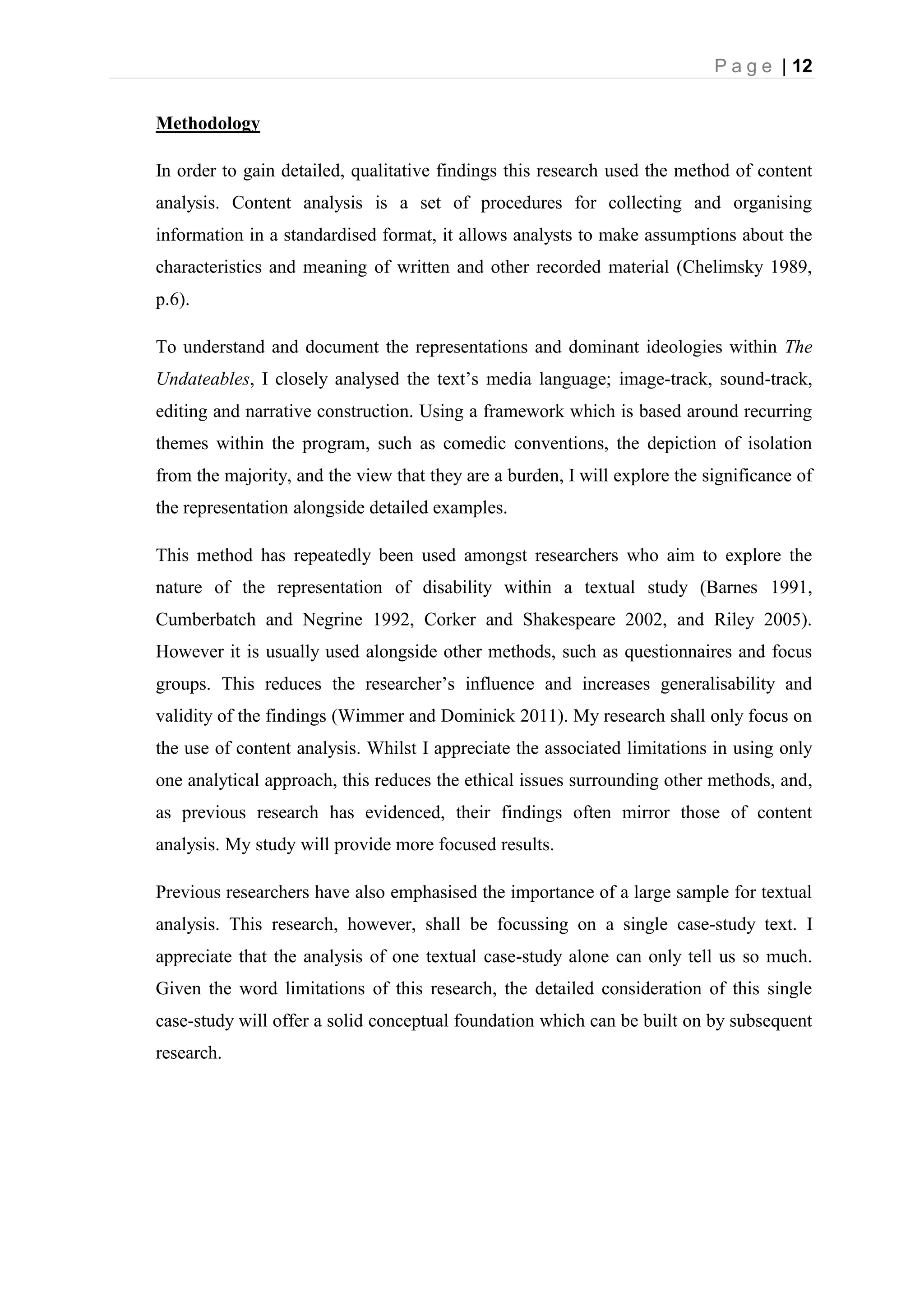
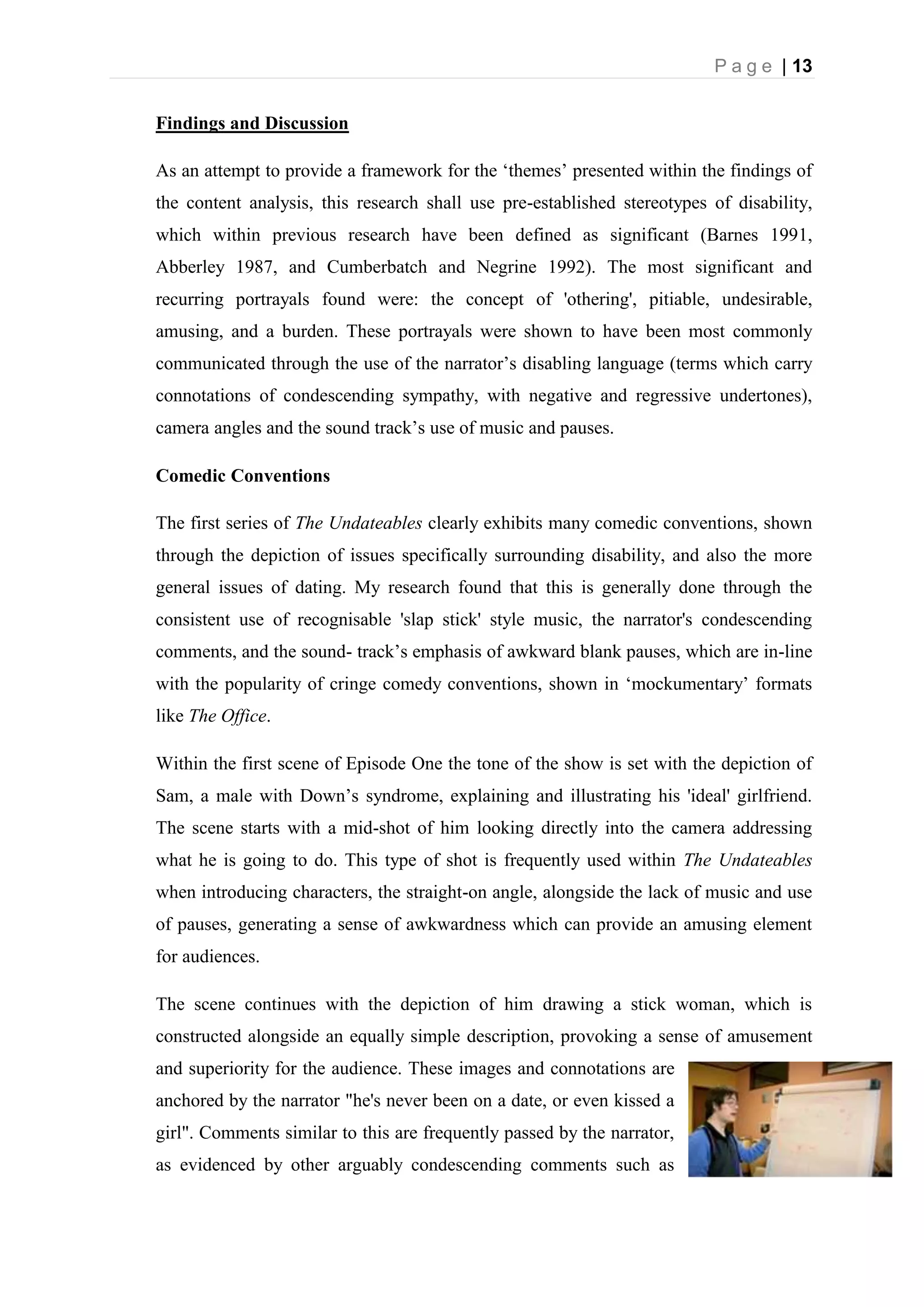
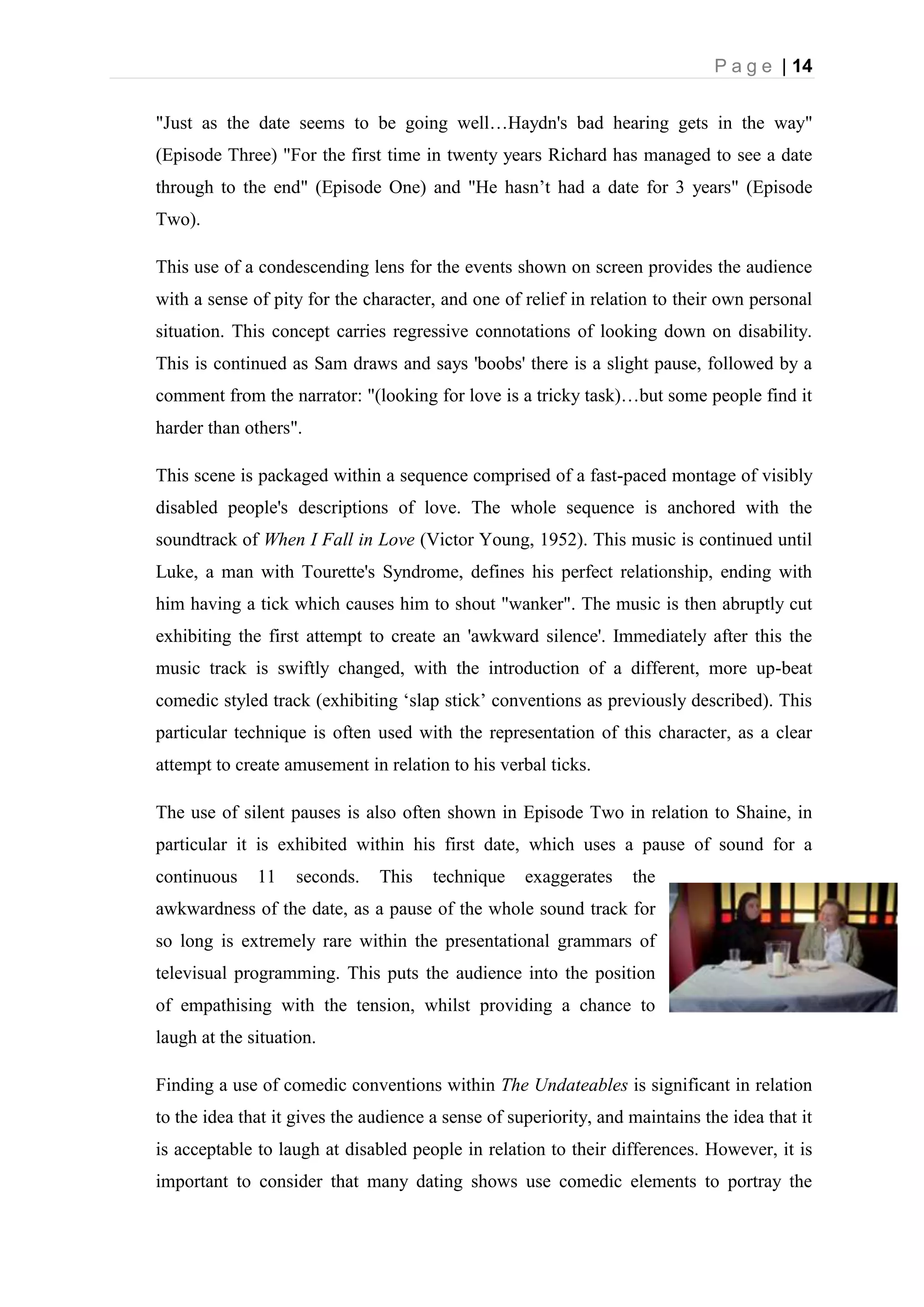


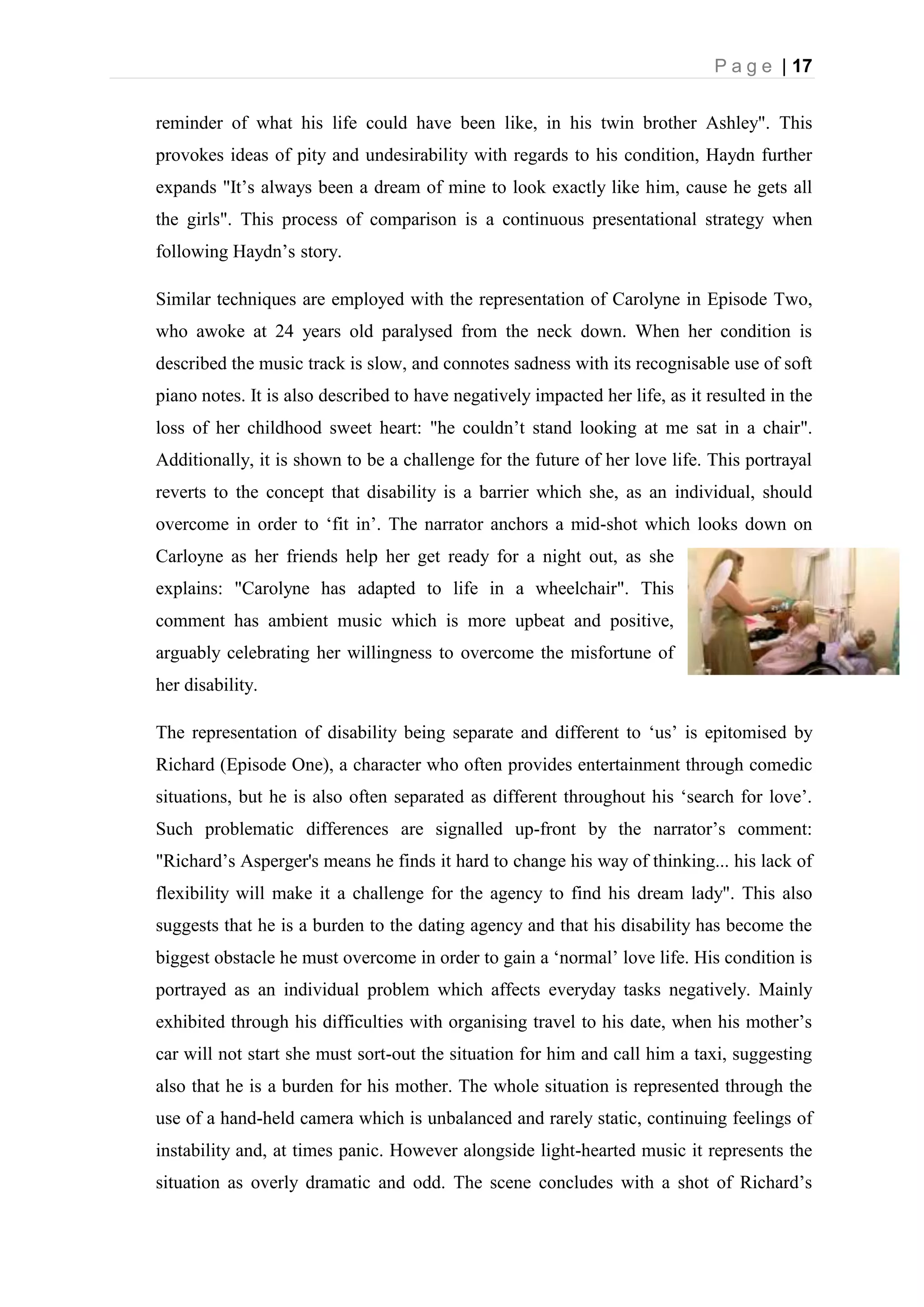
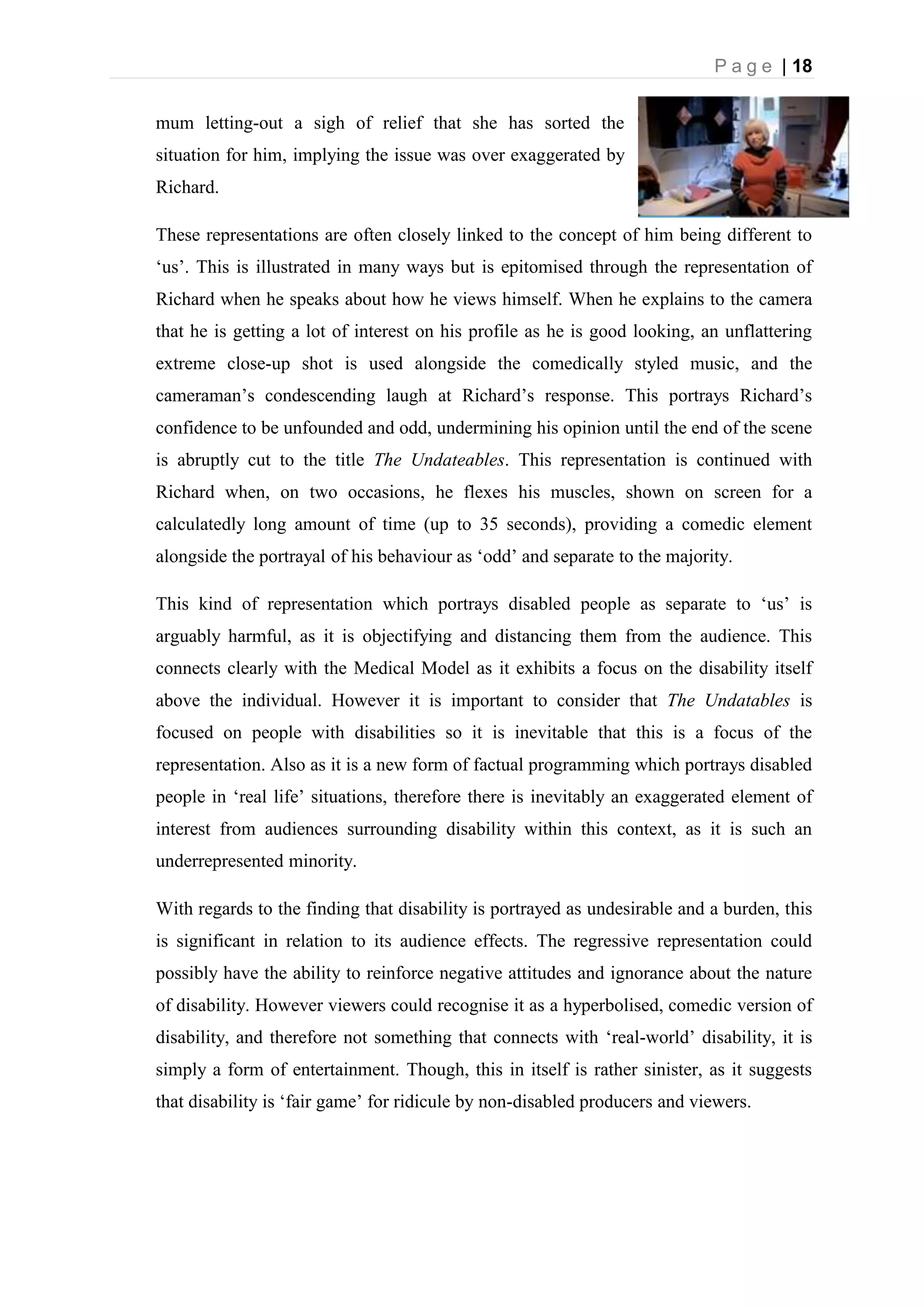
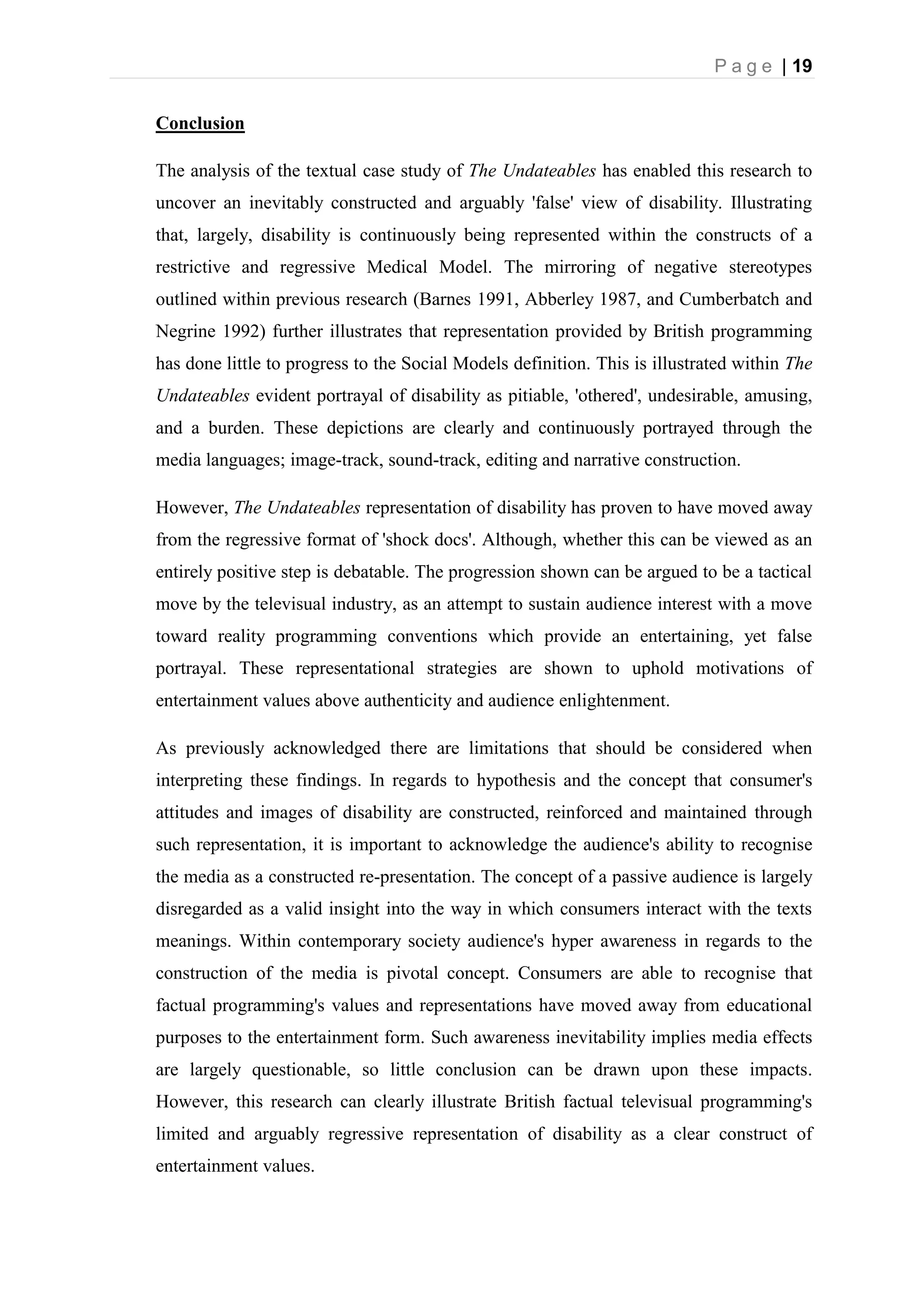
![P a g e | 20
Bibliography
ABBERLEY, Pl (1987) The concept of oppression and the development of a social
theory of disability. Disability, Handicap and society, 2 (1)
ARMSTRONG (2004) The development of realism in documentary, Understanding
Realsim [online] last accessed on 10.4.13 at:
http://www.godnose.co.uk/downloads/alevel/documentary/realism%20armstrong.pdf
BARNES, C (2000) A working social model? Disability, work and disability politics
in the 21st century [online] Critical Social Policy, 20 (4) 441-457 Article from Sage
Journals, last accessed 6.3.13 at http://csp.sagepub.com/content/20/4/441.short
BARNES, C and MERCER, G (2003) Disability. Cambridge, Polity Press
BARNES, C (1991) Disabling Imagery and the media: an exploration of the
principles of media representations of disabled people. Ryburn Publishing
BAYMAN (1997) cited in SWAIN, J et al (eds.) (2005) Controversial issues in a
disabling society. USA, Open University press
BIGNELL, J (2008) An introduction to television studies. 2nd ed., England,
Routledge
BIRESSI, A and NUNN, H (2005) Reality TV, Realism and revelation. London,
Wallflower Press
BLANCHARD, S and MORLEY, D (eds.) (1982) What's this channel four?: An
alternative report. Comedia Pub. Group
Bodyshock (2003) [online] Channel Four. September. From Channel Four On
Demand last accessed 13.03.13 at:
http://www.channel4.com/programmes/bodyshock/4od
Born to be different (2011) [online] Channel Four. 9th
June. From Channel Four On
Demand last accessed 13.03.13 at: http://www.channel4.com/programmes/born-to-be-
different/4od
CHANDLER, D (2002) Semiotics: the basics. Routledge
CHAPMAN, J (2009) Issues in Contemporary Documentary. Polity Press](https://image.slidesharecdn.com/0a05fe97-dd58-4662-badd-bf20925ebb42-150224103145-conversion-gate02/75/Dissertation-20-2048.jpg)
![P a g e | 21
CHELIMSKY (1989) Content Analysis: A Methodology for Structuring and
Analyzing Written Material, United States General Accounting Office [online] last
accessed 13.03.13 at: http://archive.gao.gov/d48t13/138426.pdf
CORKER, M and SHAKESPEAR, T (eds.) (2002) Disability/Postmodernity:
Embodying Disability Theory. Continuum International Publishing Group Ltd.
CUMBERBATCH, G and NEGRINE, R (1992) Images of disability on television.
Routledge
DAVIS, L (1995) Enforcing Normalcy: Disability, Deafness and the body. London,
Verso
DYER, R (1985) cited in LACEY, N (2009) Image and representation, key concepts
in media studies. 2nd ed. London, Palgrave
Extraordinary People (2009) [online] Channel Five. 6TH
May. From Channel Five,
Demand Five last accessed 13.03.13 at: http://www.channel5.com/shows/extraordinary-
people/episodes
GUNTER, B. (1986) Television and sex-role stereotyping. London, John Libbey.
HALL, A (2006) Reading Realism: Audiences' Evaluations of the Reality of Media
Texts, Journal of Communication 53 (4) 624-641
HALL, S (eds.) (1997) Representation, cultural representations and signifying
practices. London, Sage
HEVEY (1992) cited in BARNES, C (1992) Disabling imagery and the media: an
exploration of the principles of media representations of disabled people. Ryburn
Publishing
HOLMES, S (eds.) (2004) Freak Shows' of the 20th Century. Routledge
JERSLEV, A (eds.) (2002) Realism and 'reality' in Film and Media: Northern Lights
Film and Media Studies Yearbook. Museum Tusculanum Press
LACEY, N (2009) Image and representation, key concepts in media studies. 2nd
ed.
London, Palgrave
MARKS, D (1999) Disability; controversial debates and psychosocial perspectives.
London, Routledge](https://image.slidesharecdn.com/0a05fe97-dd58-4662-badd-bf20925ebb42-150224103145-conversion-gate02/75/Dissertation-21-2048.jpg)
![P a g e | 22
MENSILANG, L (2011) Concept of an active audience. Scribd [online] last accessed
26.03.13 at: http://www.scribd.com/doc/17052318/Concept-of-Active-Audience
MUCHLEMANNS, N (2013) Undateables is back and it still gets it all wrong.
Disability arts online [online] last assessed 13.03.13 at:
http://www.disabilityarts.org/?location_id=1915&item=1666
MULVANY, J (2000), Disability, impairment or illness? The relevance of the social
model of disability to the study of mental disorder, Sociology of Health & Illness, 22
(5) 582-601
PERKINS, T (1997) cited in LACEY, N (2009) Image and representation; key
concepts in media studies. 2nd ed. London, Palgrave
POPP, V.R et al (1981) Preschool children's recognition and acceptance of three
physical disabilities, Child Study Journal, 11 (1981), 99–114
RAYNER, P et al. (2004) As Media studies: The essential introduction. 2nd
ed.
Routledge
RILEY, C (2005) Disability and the media, prescriptions for change. University Press
of New England
RYAN, F (2012) The Undateables? Disability rights, but Channel 4 wrongs, The
Guardian, TV and Radio Blog [online] last accessed 16.03.13 at:
http://www.guardian.co.uk/tv-and-radio/tvandradioblog/2012/apr/02/undateables-
channel-4-disability-rights-wrongs
SIMPSON, A (eds.) (1998) Responding to media violence, starting points for
classroom practice. Metropolitan Toronto School Board
SWAIN, J et al. (eds.) (2005) Controversial issues in a disabling society. USA, Open
University press
Take Me Out (2010) [online] ITV. From ITV, last accessed 8.4.13 at :
http://www.itv.com/takemeout/
THOMAS, C (2004) in SWAIN, J et al (eds.) (2004) Disabling Barriers- Enabling
environments, London, Sage
TOPLISS, E (1982) Social Responses to handicap. Longman](https://image.slidesharecdn.com/0a05fe97-dd58-4662-badd-bf20925ebb42-150224103145-conversion-gate02/75/Dissertation-22-2048.jpg)
![P a g e | 23
TREGASKIS, C (2004) Constructions of disability, researching the interface between
disabled and non-disabled people. Routledge
The Undateables (2012) [online] Channel Four. 3rd
April. From Channel Four On
Demand. Last accessed 13.03.13 at: http://www.channel4.com/programmes/the-
undateables/4od#3358598
UPIAS (1976) cited in SWAIN, J (2004) (eds.)Disabling Barriers, Enabling
environments, 2nd
ed. Sage
WARDE, C et al. (2006) Media Coverage and Audience Reception of Disfigurement
on Television. Cardiff University [online] last accessed on 6.04.13 at:
http://www.cardiff.ac.uk/jomec/resources/09mediacoverageofdisfigurement.pdf
WIDLEY, R (2012) Will the 'crip' factor make the undateables unwatchable? Huff
post entertainment [online] last accessed on 13.03.13 at :
http://www.huffingtonpost.co.uk/lee-ridley/the-undateables-
unwatchable_b_1397039.html
WILSON, P (2012) Whats real? Dramatic and documentary realism, Media literacies
for the 21st
century [online] last accessed on 15.4.13 at:
http://medialiteracies21st.blogspot.co.uk/2012/02/really-conventions-of-realism-in.html
WIMMER, R and DOMINICK, J (2011) Mass media research, an introduction. 9th
ed. Wadsworth Cengage Learning
World Health organisation, WHO (1980) cited in Michigan Disability Rights
Coalition, Medical Models of Disability [online]. Last accessed 13.03.13 at:
http://www.copower.org/models-of-disability/181-medical-model-of-disability.html](https://image.slidesharecdn.com/0a05fe97-dd58-4662-badd-bf20925ebb42-150224103145-conversion-gate02/75/Dissertation-23-2048.jpg)